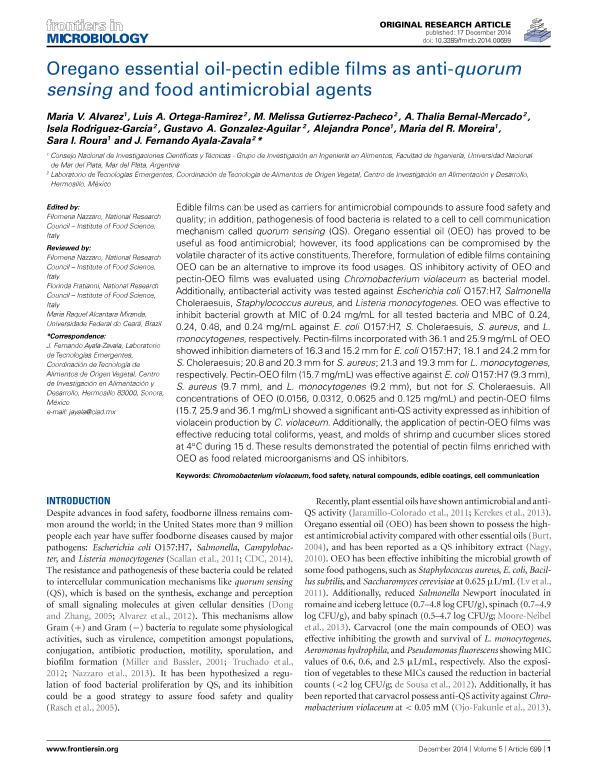Mostrar el registro sencillo del ítem
dc.contributor.author
Alvarez, María Victoria

dc.contributor.author
Ortega Ramirez, Luis Alberto
dc.contributor.author
Gutierrez Pacheco, Maria Melissa
dc.contributor.author
Bernal Mercado, Thalia
dc.contributor.author
Rodriguez Garcia, Isela
dc.contributor.author
Ponce, Alejandra Graciela

dc.contributor.author
Moreira, Maria del Rosario

dc.contributor.author
Roura, Sara Ines

dc.contributor.author
Ayala Zavala, Jesús Fernando
dc.date.available
2018-02-01T14:17:01Z
dc.date.issued
2014-11
dc.identifier.citation
Alvarez, María Victoria; Ortega Ramirez, Luis Alberto; Gutierrez Pacheco, Maria Melissa; Bernal Mercado, Thalia; Rodriguez Garcia, Isela; et al.; Oregano essential oil-pectin edible films as anti-quorum sensing and food antimicrobial agents; Frontiers; Frontiers in microbiology; 5; 699; 11-2014; 1-7
dc.identifier.issn
1664-302X
dc.identifier.uri
http://hdl.handle.net/11336/35358
dc.description.abstract
Edible films can be used as carriers for antimicrobial compounds to assure food safety andquality; in addition, pathogenesis of food bacteria is related to a cell to cell communicationmechanism calledquorum sensing(QS). Oregano essential oil (OEO) has proved to beuseful as food antimicrobial; however, its foodapplications can be compromised by thevolatile character of its active constituents.Therefore, formulation of edible films containingOEO can be an alternative to improve its food usages. QS inhibitory activity of OEO andpectin-OEO films was evaluated usingChromobacterium violaceumas bacterial model.Additionally, antibacterial activity was tested againstEscherichia coliO157:H7,SalmonellaCholeraesuis,Staphylococcus aureus,andListeria monocytogenes. OEO was effective toinhibit bacterial growth at MIC of 0.24 mg/mL for all tested bacteria and MBC of 0.24,0.24, 0.48, and 0.24 mg/mL againstE. coliO157:H7,S.Choleraesuis,S. aureus, andL.monocytogenes, respectively. Pectin-films incorporated with 36.1 and 25.9 mg/mL of OEOshowed inhibition diameters of 16.3 and 15.2 mm forE. coliO157:H7; 18.1 and 24.2 mm forS.Choleraesuis; 20.8 and 20.3 mm forS. aureus; 21.3 and 19.3 mm forL. monocytogenes,respectively. Pectin-OEO film (15.7 mg/mL) was effective againstE. coliO157:H7 (9.3 mm),S. aureus(9.7 mm), andL. monocytogenes(9.2 mm), but not forS.Choleraesuis. Allconcentrations of OEO (0.0156, 0.0312, 0.0625 and 0.125 mg/mL) and pectin-OEO films(15.7, 25.9 and 36.1 mg/mL) showed a significant anti-QS activity expressed as inhibition ofviolacein production byC. violaceum. Additionally, the application of pectin-OEO films waseffective reducing total coliforms, yeast, and molds of shrimp and cucumber slices storedat 4◦C during 15 d.These results demonstrated the potential of pectin films enriched withOEO as food related microorganisms and QS inhibitors
dc.format
application/pdf
dc.language.iso
eng
dc.publisher
Frontiers
dc.rights
info:eu-repo/semantics/openAccess
dc.rights.uri
https://creativecommons.org/licenses/by-nc-sa/2.5/ar/
dc.subject
Chromobacterium Violaceum
dc.subject
Cell Communication
dc.subject
Edible Coatings
dc.subject
Food Safety
dc.subject
Natural Compounds
dc.subject.classification
Otras Ciencias Biológicas

dc.subject.classification
Ciencias Biológicas

dc.subject.classification
CIENCIAS NATURALES Y EXACTAS

dc.title
Oregano essential oil-pectin edible films as anti-quorum sensing and food antimicrobial agents
dc.type
info:eu-repo/semantics/article
dc.type
info:ar-repo/semantics/artículo
dc.type
info:eu-repo/semantics/publishedVersion
dc.date.updated
2018-01-30T19:06:19Z
dc.journal.volume
5
dc.journal.number
699
dc.journal.pagination
1-7
dc.journal.pais
Suiza

dc.journal.ciudad
Lausanne
dc.description.fil
Fil: Alvarez, María Victoria. Consejo Nacional de Investigaciones Científicas y Técnicas; Argentina. Universidad Nacional de Mar del Plata. Facultad de Ingeniería. Departamento de Ingeniería Química. Grupo de Investigación en Ingeniería En Alimentos; Argentina
dc.description.fil
Fil: Ortega Ramirez, Luis Alberto. Centro de Investigación en Alimentación y Desarrollo. Hermosillo; México
dc.description.fil
Fil: Gutierrez Pacheco, Maria Melissa. Centro de Investigación en Alimentación y Desarrollo. Hermosillo; México
dc.description.fil
Fil: Bernal Mercado, Thalia. Centro de Investigación en Alimentación y Desarrollo. Hermosillo; México
dc.description.fil
Fil: Rodriguez Garcia, Isela. Centro de Investigación en Alimentación y Desarrollo. Hermosillo; México
dc.description.fil
Fil: Ponce, Alejandra Graciela. Consejo Nacional de Investigaciones Científicas y Técnicas; Argentina. Universidad Nacional de Mar del Plata. Facultad de Ingeniería. Departamento de Ingeniería Química. Grupo de Investigación en Ingeniería En Alimentos; Argentina
dc.description.fil
Fil: Moreira, Maria del Rosario. Consejo Nacional de Investigaciones Científicas y Técnicas; Argentina. Universidad Nacional de Mar del Plata. Facultad de Ingeniería. Departamento de Ingeniería Química. Grupo de Investigación en Ingeniería En Alimentos; Argentina
dc.description.fil
Fil: Roura, Sara Ines. Consejo Nacional de Investigaciones Científicas y Técnicas; Argentina. Universidad Nacional de Mar del Plata. Facultad de Ingeniería. Departamento de Ingeniería Química. Grupo de Investigación en Ingeniería En Alimentos; Argentina
dc.description.fil
Fil: Ayala Zavala, Jesús Fernando. Centro de Investigación en Alimentación y Desarrollo. Hermosillo; México
dc.journal.title
Frontiers in microbiology
dc.relation.alternativeid
info:eu-repo/semantics/altIdentifier/doi/http://dx.doi.org/10.3389/fmicb.2014.00699
dc.relation.alternativeid
info:eu-repo/semantics/altIdentifier/url/https://www.frontiersin.org/articles/10.3389/fmicb.2014.00699/full
Archivos asociados
